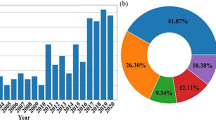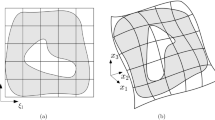Abstract
A method for direct imposition of essential boundary condition and treatment of material discontinuity in element free galerkin (EFG) method is presented. By using the actual displacements at the nodes on the essential boundary and the material interface in each material domain, the stiffness matrix and load vector at an integral point have been rewritten and transformed. As a result, the proposed method yields a positive, symmetrical and banded global stiffness matrix like it is in finite element methods and has the advantages of stabilization and easy implementation as compared to the penalty method, the Lagrange method, and other methods. Numerical results indicate that the present method is effective and retains high rates of convergence for both displacements and energy.
Similar content being viewed by others
Author information
Authors and Affiliations
Corresponding author
Rights and permissions
About this article
Cite this article
Cai, Y., Zhu, H. Direct imposition of essential boundary conditions and treatment of material discontinuities in the EFG method. Computational Mechanics 34, 330–338 (2004). https://doi.org/10.1007/s00466-004-0577-x
Received:
Accepted:
Published:
Issue Date:
DOI: https://doi.org/10.1007/s00466-004-0577-x




